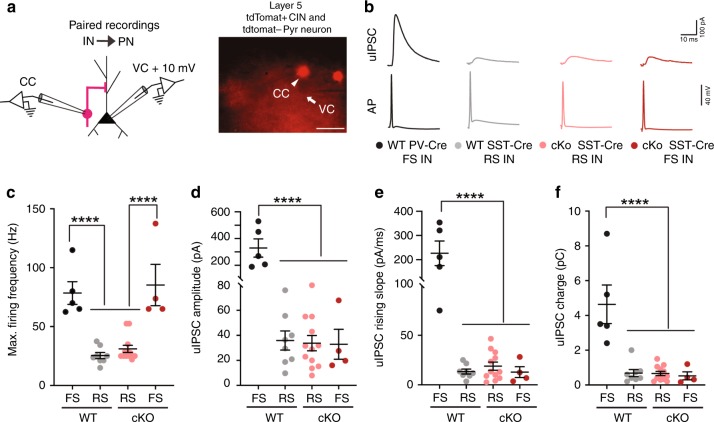Fig. 6.
FS/SST-Cre CINs in Tsc1 cKOs send their outputs to distal dendrites of pyramidal neurons. a Left, Experimental design: Simultaneous recordings were obtained from connected layer 5 tdTomato+ CINs, (current clamp, CC) and pyramidal neurons, (voltage clamp, VC), +10 mV. Right, representative image showing patch pipettes targeting tdTomato+ CIN (arrowhead) and tdTomato− pyramidal neuron (arrow). Scale bar is 50 µm. b Example unitary inhibitory post synaptic currents (uIPSCs) recorded in pyramidal neurons generated in response to action potentials (AP) in WT FS/PV-Cre CINs (black, 5 pairs), WT RS/SST-Cre CINs (grey, 8 pairs), cKO RS/SST-Cre CINs (salmon, 12 pairs) and cKO FS/SST-Cre CINs (red, 4 pairs). c Maximum firing frequency of four groups of CINs is compared: One-way ANOVA with Tukey’s test: (F3, 25 = 20, P < 0.0001; FS vs. RS p < 0.0001). d–f uIPSC amplitude, rising slope and total charge is compared. One-way ANOVA with Tukey’s test, uIPSC amplitude (d): (F3, 25 = 29, P < 0.0001; WT FS/PV-Cre vs. all groups p < 0.0001); rising slope (e): (F3, 25 = 28.11, P < 0.0001; WT FS/PV-Cre vs. all groups p < 0.0001); and total charge (f): (F3, 25 = 18, P < 0.0001; WT FS/PV-Cre vs. all groups p < 0.0001). Data are presented as mean ± S.E.M. ****p < 0.0001. Source data are provided as a Source Data file

